I remember a day when I was waiting in the vet’s office for my dog’s appointment. The man sitting next to us started telling me, with beaming pride, about how his little white Westie had caught seven barn rats in the past week.
I couldn’t help but admire this cute, fluffy dog’s superior hunting skills. Predatory behavior in dogs is something I respect. From following a scent trail, to stalking a bird, chasing a ball, or herding sheep, I am intrigued with the many forms predatory behavior manifests in our dogs; it is part of what makes dogs so amazing!
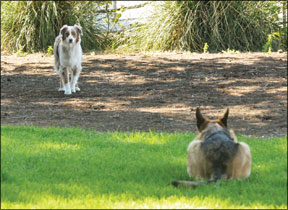
288
But, predatory behavior is not so admirable (and much less socially acceptable), when, instead of it being a country terrier ridding a barn of rats or an Aussie herding sheep, it is your city dog chasing a skateboarder or the neighbor’s cat.
Predatory behavior in our dogs can be admirable, but it’s also something to understand, respect, and channel into appropriate activities.
What is predatory behavior?
This may seem obvious. Predatory behavior, commonly called “prey drive” in our pet dogs, is an instinctive or natural desire to chase, capture, and kill prey. It is, in the most fundamental sense, about acquiring food.
Predatory behaviors are generally triggered by something in the environment (for example, an animal running or a ball flying through the air) and happen as a reflexive or automatic response. When an object moves or an animal runs, a puppy or dog may reflexively chase. Because predatory behavior is instinctive, a dog does not need to be taught how to do this; it comes naturally.
Predatory behavior takes many forms, including searching, stalking, chasing, catching, killing, carrying, dissecting, and eating behaviors. Wild canids, like wolves and coyotes, need and use all behaviors in the sequence to hunt and survive. Our domestic dogs no longer need to hunt for food, yet they still have active predatory behaviors.
All dogs are born with different levels of prey drive. Some enjoy chasing a ball or even a cat, but would never hurt the kitty (or the ball). Others are literally fixated on movement. Still others will seek out and kill mice, rats, gophers, or squirrels.
Breed type is a major predictor of a dog’s predatory behavior. Because of selective breeding, certain predatory behaviors have remained strong in certain breeds, while other behaviors may be diminished. For example, retrievers may have the search and carry pieces of the predatory sequence, but the dissecting piece may be suppressed. Border Collies are famous for their eye-stalk and chase skills, but the bite and kill aspects are often absent. Many terriers have been bred so that all aspects of the predatory sequence remain strong.
Experience and opportunity are other factors that determine how predatory a dog will be. From scenting to chasing to catching and killing, predatory actions can be extremely rewarding for dogs. If a dog has the opportunity to chase or hunt, she is much more likely to do it again in the future.
When is predatory behavior a problem?
Because the extent and intensity of a dog’s predatory behavior can vary dramatically, there is no single answer to when it may be a problem. “Some dogs are meant for critter control,” said Daphne Robert-Hamilton, a certified trainer and aggression specialist in Morgan Hill, California. As long as the dog is focused on her critter control job, and doing that job doesn’t hurt the dog, then the predatory behavior may not be a problem at all.
Predatory behavior is most often a problem when a dog focuses it on an unacceptable target. For example:
- Chasing cars, bicyclists, or skateboarders or “herding” running children
- Nipping people in the heels, calves, or thighs as they run or move away
- Chasing cats or other small animals (including small dogs)
In addition, predatory behavior can be problematic if a dog puts himself in danger, or is so obsessed that she cannot focus on other things. Robert-Hamilton also emphasizes that intense or aroused chase – especially toward humans, cats, or things that can hurt the dog – is almost always a serious problem.
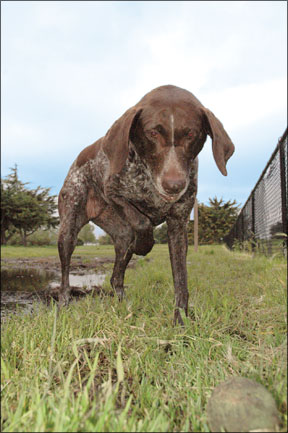
288
Can predatory behavior be eliminated?
As someone who has shared my home with dogs who exhibit very strong predatory behaviors, I know they can be some of the most difficult behaviors for people to live with. And problematic predatory behaviors can be some of the hardest to modify. Even the most wonderful treats in the world are not likely to compete with the reward of predatory behavior.
You may ask at this point, “Why not try to stop a dog from chasing or hunting altogether? Isn’t this one of the rare times to use punishment?” I’ve learned through experience that when a dog’s instinctive behavior kicks in, punishment may not work – at least not with any consistency. I have known dogs who would run right through the shock of an electric collar in hot pursuit of a rabbit.
I do not believe you can reliably “control” predatory behavior by suppressing it or correcting it. But I know you can channel your dog’s predatory behavior, and that with a combination of management, providing appropriate outlets, and training, even dogs with the strongest predatory inclinations can be well-behaved.
Manage first
Management is a useful tool for controlling or modifying most of your dog’s behaviors, but it may be even more critical with predatory behaviors. Why? Because predatory behavior is extremely self-rewarding. If your dog is inclined to hunt and given the opportunity to hunt, he’ll do it!
Consider this: Dogs will chase squirrels even if they’ve never caught one. They don’t need to actually get the reward of catching the squirrel; the act of chasing is its own reward. Predatory chasing causes the release of certain feel-good chemicals in his body. Going after the squirrel is more than just fun. It creates a sort of natural high that makes a dog want to do it more and more.
If your dog enjoys chasing squirrels on a regular basis, it may be much harder to stop her from chasing squirrels when you’d rather she was focusing on other things, such as running agility or coming when called. When you limit access to undesired hunting or chasing, you prevent the dog from practicing the behavior, and from getting the self-reward.
Channel it!
But while limiting a dog’s opportunity to practice predatory behaviors is an important first step, and may curb the dog’s desire to chase one particular target, it will not squelch the dog’s need to chase something. That is why channeling the drive is so important. It may be difficult (or impossible!) to teach a dog to stop wanting to scent, stalk, or chase, but you can easily teach him what to scent, stalk, or chase.
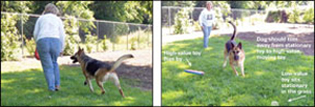
315
For example, dogs who love to chase things can be taught to chase a certain object, like a ball or a Frisbee. Dogs who need to stalk may be good candidates for herding. Scenting activities can provide an outlet for dogs for whom sniffing and finding is extremely rewarding. Dog sports like flyball and agility engage aspects of predatory behavior and can provide an excellent channel for active and athletic dogs. Games like tug and playing with food toys such as stuffed Kongs can be part of focusing a dog’s desire to dissect.
For many dogs, a little management and providing appropriate outlets will be enough to stop them from problematic predatory behavior. But for some dogs, those who are truly driven to search, chase, and catch, these steps will be only the beginning.
Harnessing the drive
Harnessing predatory behaviors and using them in training can have a big payoff. By using the need to chase, grab, and bite as a reward, you can develop reliable responses in dogs with even the strongest predatory instincts. In fact, strong predatory inclination is one the most sought-after features in many types of working dogs and those who participate in dog sports. The stronger the search, chase, and grab behaviors, the better the dog may be at agility, flyball, search and rescue, and drug scenting. And predatory behavior is the obvious force behind every great herding dog, pointer, and retriever.
The key to harnessing predatory behavior is to teach your dog to fixate on something that is within your control (like a toy or tug item), instead of something that is not within your control (such as squirrels, bunnies, or cats). Basically, you can teach a dog that a tug toy or a retrieve item is their “prey” and that you are in control of the prey. Developing a strong interest in playing a game that provides an outlet for her predatory behavior can redirect her formerly problematic predatory behavior into a dog focused on working with you.
The more you succeed at getting your dog to focus on working with you for her play/prey object, the more important you are in the game and the less significant the environment around you becomes. Focusing a dog with strong predatory instincts is easiest to do with a puppy or young dog who hasn’t already enjoyed hunting, but it is possible to refocus a dog who has had practice fixating on the wrong target, too.
Teach self-control
Self-control is another critical skill for dogs with a high prey drive. One of the best ways to help dogs learn self-control is by teaching a sort of on/off switch. Help your dog learn to switch between being in an excited state (like when playing tug) to a thinking, focused state (like when heeling calmly beside you). Frequently interrupting tug or other exciting games by asking for calm behaviors like sit, down, or heel can help a dog learn to quickly move from excited to calm.
While it may seem that playing tug and chasing squirrels have little in common, the ability to switch from an excited state to a calmer state will improve a dog’s ability to think, instead of simply react, when predatory instincts kick in.
Another critical behavior for developing self-control in dogs is teaching a strong “leave it” or “off.” Teaching “leave it” helps a dog learn to disengage from whatever he is interested in, whether it is an interesting smell on the ground or a squirrel in a tree above.
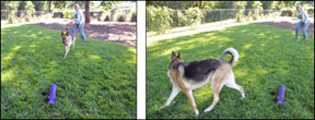
315
When teaching “leave it” with predatory dogs, the reward must be proportional to what you are asking the dog to leave. For example, a dog who is asked to leave a running squirrel will not be satisfied with a bland biscuit for a reward. A super high-value food item might work, but an intense game of chase and tug is likely to work better.
The third self-control exercise that I find particularly helpful with predatory dogs is a strong “wait.” Different than a stay exercise, I use “wait” to mean “Hold on, you will get to go do what you want, but you must pause a minute first.” For dogs who are excited to run or chase, waiting a moment can help them learn that good things come when you listen to and hear what your person is saying. Practicing “wait” before being allowed to chase a ball, running off-leash with dog pals, or going to a food bowl for dinner can be great self-control exercises.
Teaching a “call off”
Teaching a dog with a strong predatory instinct to quit or leave a predatory chase is a difficult training challenge, but you can be successful. Perhaps you’ve had the experience of calling your dog when he is in the midst of chasing something; did he seem to not even hear your call? Dogs who are mid-chase may be so intensely focused that they really cannot hear anything else.
Keep in mind that every dog is different; the strategy described here may need to be tweaked to fit your dog or your unique set of circumstances. It’s okay to experiment and find the approach that works best for you and your dog.
- The foundation: Developing a valuable reward. First, you’ll need to identify and/or develop a reward or reinforcement that your dog is passionate about. For dogs who are obsessive about retrieving, a chance to retrieve will work well as a reward because you will reward a “call off” of chasing with an equally exciting game of fetch. (Most dogs who do predatory chasing enjoy chasing any moving object!) An obsessive retrieve means your dog will chase and bring back a ball, Frisbee, tug toy, Kong, or other item enthusiastically and every time.
It may take a few weeks or months to build that intense toy drive in dogs who are less obsessive about retrieving. But the results – getting a dog really passionate about retrieving – will be worth the effort. Start slowly and enthusiastically and always stop the game while your dog still wants to play. I’ve found that short, exciting tosses (rather than long throws) get a dog super-excited and eager to continue the game. In addition, combining the retrieve with a rousing game of tug can increase the value of the game for many dogs.
- Choose a word or sound for your “call off” signal or cue. Make it different than your usual cue for coming when called. It should be something that you can say fast and loud in an emergency, so pick something that will roll off of your tongue naturally. It could be a whistle or something like “Hey!” or “Ready?”
- Teach your dog that your sound or word means a retrieving game is about to begin. Give your signal (“Ready?”); throw his favorite toy; and when your dog brings it back, play a great game (for example, throw it again quickly or play tug). You will know your dog understands the signal when you say it and your dog starts looking for the toy before it is tossed. You are conditioning your dog to know that the “Ready?” signal is a powerful indicator that a chase game is about to begin.
- First part of the “call off” exercise: an easy choice. Ask your dog to wait (if he’s familiar with that behavior) or have a friend hold his collar while you place (not toss) a low-value toy about 20 feet from your dog. Then release your dog to get the toy. If you usually release him from a “wait” behavior with a cue – such as “Okay!” or “Free!” – you can use that word; if you had a friend holding his collar, she can simply release it.

315
Before he takes even a step, say “Ready?” and throw your dog’s favorite retrieve toy right in front of him. If your dog is faced with a low-value toy not moving in the grass, and a high-value toy flying through the air, he’ll likely chase the exciting, flying toy and ignore the low-value toy.
Timing is everything; you will need to be fast enough to throw the exciting toy before your dog gets to the less-interesting toy. Don’t worry if your dog doesn’t bring back the exciting toy, or stops to investigate the low-value toy. At first, all you want is for your dog to orient to the moving toy instead of the stationary toy.
- Gradually make the game harder by having the less-interesting toy move slowly, then faster, until you can release your dog while the less-exciting toy is in motion. For example, roll the low-value toy slowly away, wait for it to almost stop, and then release your dog. Once your dog can easily resist going toward a moving low-value toy and opt for chasing the exciting toy, you can start to change your criteria even more.
- Change your criteria in several ways. First, teach your dog to turn away from the less-interesting toy. Start again with the less-interesting toy in a stationary position, release your dog, say “Ready?”, and then throw the exciting toy in a different direction, so your dog has to turn away from the less interesting toy toward the more exciting toy to engage in the chase.
Another way to increase criteria is to change the less-interesting toy, and gradually make it more interesting until your dog will call off of toys of equal value. - Take your time. Your goal is to be able to throw a high-value toy for your dog, say “Ready?” (or your own unique signal) when your dog is an mid-chase, so that he will whip around and run toward you to chase a different high-value toy that you throw in the opposite direction. Eventually you may be able to ask your dog for a quick “sit” in front of you before the second throw.
Getting to this point takes a lot of practice. It may take some dogs a few weeks, and others many months to get to this level of response.
Note: I prefer to train all of the previous steps totally off-leash and raise the criteria very slowly to ensure success. I feel this will best translate to off-leash work later on. But if you need to practice in places where you are not sure of your dog’s safety, use a long line. In addition, if you are having trouble at any step along the way, you can use a long line to help you over the problems at that stage.
- “Proof” your dog on “call offs” by making the game varied and more realistic. Call him off of increasingly interesting (and increasingly prey-like) things, such as a remote control toy or car (with a plastic bag attached to the antenna to simulate a tail), a fuzzy toy attached to a stick with a string (like a fishing pole), or other props that you can move in random ways. (Be careful though, not to set him up to fail, by making the item too irresistible.) This will help your dog learn that the game is the same no matter what moving object is used.
- Real-life exercises. Once you are able to call off your dog from a variety of moving objects, you will need to help your dog learn to call off of whatever your dog is usually hot to pursue. Start by going near a place with squirrels or bunnies or bicycles or whatever usually triggers your dog’s predatory behavior. Don’t go too close to the actual animals or objects; you want to set up your dog for success. At this point, you do want to have your dog on a long line so if you make a mistake, he cannot chase that bunny or squirrel. Use the previous exercises to practice the call off. Your dog will be able to smell and sense the animals, and will be learning that the game is the same, even when his former “prey” are nearby.
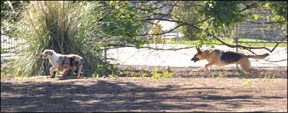
288
What happens if your dog does take off and chase? Your dog is on the long line, so you can stop the chase, but you will end your session for the day and try again another day. Review the previous exercises in a low-distraction environment. And when you try to return to the area where your dog failed, start much farther away from the “prey.”
If you’ve practiced a lot, and all your work has gone well, you may be able to work up to doing these exercises in the same area as the prey, with your dog off-leash. Please be careful. Some dogs may never get to the point where they can be off-leash around the animals or activities that stimulate their predatory behavior. Your call off work will help if ever, by accident, he gets into a chase, but a truly prey-obsessed dog or one with a long history of predatory chasing may always have to be kept on a long line.
Things to remember
While you are teaching the call off, you need to control access to whatever your dog chases; you are essentially redirecting your dog’s desire to chase into a more acceptable target. This will not work as well if your dog can chase those squirrels at will.
Make sure you work on regular obedience and self-control exercises, too. The more responsive to you that your dog is, the better he will respond in arousing situations.
Have your dog practice coming when called in lots of less-exciting situations. It will help strengthen your ability to control your dog. But don’t expect him to come out of a chase using your everyday recall.
Make sure your dog has plenty of access to predatory games (like your retrieve game) that do not involve actually hunting. This will give your dog an outlet for the need to chase.
How successful can you expect to be?
For most dogs, developing a new “chase” obsession in the form of a retrieve and teaching a call off can be extremely successful. For a few dogs, especially those who have a history of chasing and/or killing other animals, you may never be able to fully trust your dog to resist the opportunity to chase.
Be aware that when you call will also have a big impact on the odds that he will respond to you. Think about what happens when a dog chases an animal (such as a rabbit or squirrel):
- He notices the animal. You may have the best success of calling your dog away at this point.
- He “locks on” – intently focusing on the animal. You may be able break his focus at this point, but it will be more difficult.
- He starts to chase. This will be very difficult to call a dog out of; remember, he may not even hear you call. However, even in mid-chase there are moments when a dog’s focus is broken and a call off will have a higher likelihood of success. For example, if the object of the chase goes out of sight, or up a tree, or gets a good distance away, you may have a better shot at a call off.
Mardi Richmond, MA, CPDT-KA, is a writer and training enthusiast, and completely enthralled with everything “wild” about dogs. She lives in Santa Cruz, CA, with her partner and a young, highly predatory, heeler-mix.
Thanks to Daphne Robert-Hamilton, CPDT-KA, of K-9 Partnership in Morgan Hill, CA, for her contributions to this article; see k9partnership.com. Thanks to members of the Santa Cruz Monday Night Training Club for sharing their experiences with their dogs’ predatory behavior. And thanks for Sarah Richardson of The Canine Connection, Chico, CA, for modeling for this article; see thecanineconnection.com.





